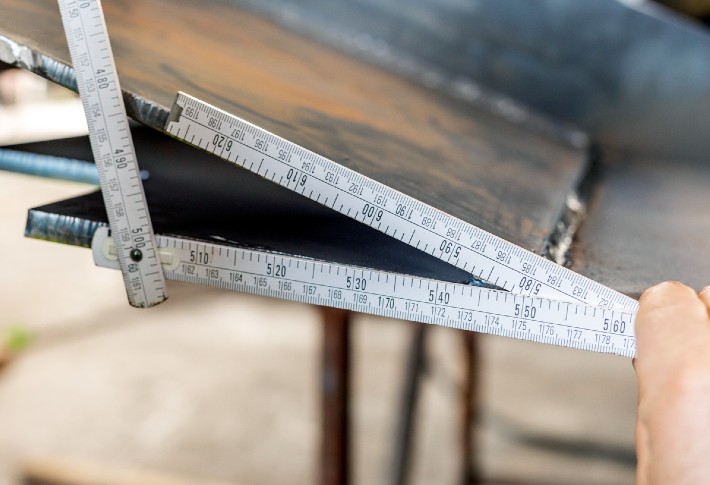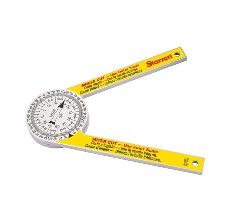Best Angle Finder to Measure with Accuracy

Doesn't matter if you are a beginner-level carpenter, a hobbyist craftsman, or a professional in the field; you will need an angle finder to make things easy for you. An angle finder is sometimes also known as the miter protractor or angle gauge. You can also use scales and compasses to find angles, but it is such a hassle, so why not take the effortless solution?
There are different models and types of angle finders, and you need to choose the one that best suits your needs. For instance, some finders come with magnets embedded in them that help in measuring bevel and miter angles. We will take a look at these features in detail later.
An angle finder can quickly help you find the angle of any shape of an object with accuracy. It will also save you the struggle of many hours. Thus, when it comes to precision and time saving, the best angle finders of 2024 are there to help you.
Our Top Picks
- Best Overall: Klein Tools Angle Finder Shop Now ➔
- Runner Up: GemRed Digital Angle Finder Shop Now ➔
- Honorable Mention: General Digital Sliding Angle Finder Shop Now ➔
- Contender: Starrett Prosite Angle Finder Shop Now ➔
- General Tools 29 - Angle Finder Shop Now ➔
Here are the Best Angle Finders of 2024
Best Overall
The Klein tools angle gauge features a measurement range of 0-90 degrees and 0-180 degrees. Hence, you can use it for multiple applications like carpentry jobs, HVAC, plumbing, and electrical. As we had mentioned earlier, some digital angle finders have a magnet attached to them. Klein angle finder has a rare and robust earth magnet in its base and edges so it can stick firmly to ducts, vents, saw-blades, pipes, and conduits.
Pros
- You can use it for many applications
- It has a strong magnetic base
- You can use it in dim areas
Cons
- It cannot be used by placing on its back
Runner Up
If you are a beginner, then it is one of the best angle finders for you. The digital angle finder has both types of measurements on its edges: imperial and metric. It gives highly accurate readings with one decimal point in minimum time. The readings are also clearly visible on the LCD screen.
The unit is durable and long-lasting, along with being compact, so you can easily carry it anywhere. You can also lock the measurements at the desired angle with a twist dial. The device is perfect to use for measuring external as well as internal angles.
Pros
- It is durable
- The battery is long-lasting
- It has a locking function to secure angles
Cons
- It gets scratched easily
Honorable Mention
As we saw that the previous angle finder was explicitly designed for beginners, an angle finder was made for professionals and experts. The product provides seamless and smooth performance, and while it may not be the most accurate digital finder in the market, it does its job effectively. The product is easy to use as it comes with a hold button to take measurements comfortably. It has a flip display and reverse display feature and a locking knob to lock the readings.
The device has an automatic shutdown feature so that if the angle finder is not being used for a while, it saves battery life. The accuracy of the measurements is 0.3 +/-, and it can measure in a range from 0 to 360 degrees.
Pros
- User friendly and easy to use
- Accurate reading
- It has a locking function to secure angles
Cons
- It is not very durable
Contender
Starrett miter saw protractor gained popularity soon and is considered to be the best angle finder. It is famous for being used with miter saw because it can measure outside and inside angles accurately and efficiently. The readings are shown in an analog display, but you can trust it to be accurate and almost with zero error. You will find two laser-engraved scales on the angle finder, and the arrows can help you figure out the exact number it is pointing to.
It is perfect to use for plumbing, carpentry, metalwork, and much more. If you are choosing this angle finder to use at home then, it can be helpful for baseboard molding and crown. The material will not scratch because it is made of plastic but, it also has a disadvantage. The unit is not very durable, and sometimes it breaks during the delivery process.
Pros
- Accurate readings
- Best for the miter saw
- Would not scratch easily
Cons
- It is not made of solid material
The last in the bunch of the best angle finders is this plastic angle finder by General tools. You can use it to measure effectively from both inside and outside a product. You can also use it to measure angles for objects with slopes. You can measure it from 0 to 180 degrees, so it is perfect for various projects like cabinet making, construction jobs, carpentry, and much more.
General tools angle finder does its job perfectly except that it has a weak construction, so it does not last very long. Plastic is used for its construction, and it is fixed in place with the help of brass lock nuts. However, it is evident from customer reviews that the product starts cracking after a few months of usage.
Pros
- You can use it to measure both interior and exterior angles
- You can use it for various projects
Cons
- It is not durable
Best Angle Finders Buying Guide
There are different varieties of angle finders, but all need to fulfill specific criteria of essential features.
How to use an Angle Finder?
Before we jump on the features, let’s understand how to use an angle finder to determine the required features accordingly.
Step 1
You begin simply by placing the angle finder on your piece of the project. It does not matter what the shape or size of your object is. Some angle finders have a magnetic base to stick to the object firmly and provide an accurate reading.
Step 2
When you have placed the angle finder, you can start taking measurements. Once you are done taking the measurements, lock the arm of the angle finder to secure the reading (if this feature is available in your device).
That’s it! You are done.
Features to Consider
To buy the best angle finder, take a quick look at the necessary features and specs.
Easy to Read Digital Display/LCD
If you will invest in a digital angle finder, then why not buy the one that provides the most efficiency and ease of use. Thus, it is best if you buy a digital protractor that has an easy-to-read LED display. The more clearly you can read the measurements, the more precise you can be with the measurements. Especially when it comes to managing big projects, it will also save you a lot of time and hassle. Some models have special features to assist in reading the LCD when it is very dimly lit or has too much brightness. These digital displays show that these angle finders are superior to the traditional analog angle finders.
Great Accuracy
When you measure angles, you would want to be as accurate as possible. Digital protractors and levels are best to choose when it comes to measuring with accuracy. Mostly, the accuracy is within a tenth of a degree, which is impossible to get with a manual angle finder. Furthermore, a digital level is essential household equipment because it can help in basic projects like crown molding.
Most professionals seek an accuracy of +/- 0.1 degrees, and for household projects, an accuracy of +/- 0.3 degrees will do the job. A feature that is closely linked to the accuracy level is the locking feature. It is best if you buy an angle finder with a locking feature so that you can efficiently lock the readings at a certain angle to use later.
Broad Measurement Range
As we have seen above as well, angle finders have different measurement ranges. It can be 0 to 90 degrees, 0 to 180 degrees, up to 0 to 360 degrees. The broader the measurement range, the more the applications of the angle finder. You can use an angle finder with a more comprehensive measurement range to measure the angles of the most versatile products. The distinguishing point between a conventional angle finder and a digital one is that the former struggles in measuring some extreme angles while the latter can do it smoothly.
What Additional Features to Find?
Apart from the necessary features, here are some additional features that can help you to buy the best angle finder:
Cut Calculator
Some advanced digital protractors have the additional feature of a cut calculator. A cut calculator ensures that you cut each piece to fit exactly how you had planned it to be. Think for instance that you spend hours cutting a piece, and at the end, you find out that you are short of 1 inch only. Won’t that be disturbing and irritating? Some companies have attached a cut calculator to avoid you getting in such situations, so you are always sure that the piece fits precisely. It can cost you some extra bucks because this feature is only present in high-end models.
Memory Storage and Battery Life
We have seen a model above that has the feature of storing the battery life. There may be times when you forget to turn off your angle finder when you don’t need it. If the angle finder has the functionality of auto shutdown, it will preserve the battery of the digital protractor when not in use. It is also helpful in increasing the battery life of the device.
Memory storage is a significant feature if you want efficiency and reliability because you can store your readings in the protractor for later use. A considerable amount of time is saved because you don’t have to measure the angles repeatedly. Once you have set them in the storage, they are saved.
Angle Finder FAQ
What is the accuracy of digital angle finders?
Digital angle finders are almost 100% accurate. There might be a tiny variation in the accuracy, but if you choose closely, you can even find an angle finder with +/- 0.1 degrees of accuracy. For household usage, accuracy with +/- 0.3 degrees of accuracy is also reliable.
Are angle finders safe to use?
The angle finders that are made with plastic are entirely safe to use. The angle finders that are made with metal arms can pinch your skin a little. To be on the safe side, experts recommend using gloves while working with angle finders. Secondly, don't use metallic angle finders in the proximity of electrical cords.
How can you increase the life of your angle finder?
We all want our product to be durable and long-lasting. However, you will have to play your little part to increase the life of a device. If you wish your angle finder to be stable, make sure to clean it after use. Furthermore, please don't drop it in water or from heights.
Article Contributors
The Woodsmith Review Team’s product reviews and in-depth guides are here to help you choose the best tools and gear to build great-looking projects confidently. Woodsmith is reader-supported: When you buy through links on our site, we may earn an affiliate commission. Large language models (like Artificial Intelligence) may have been used in the research and creation of the content.
Inquiries regarding specific articles or product testing should be sent to aimperiapt@gmail.com





